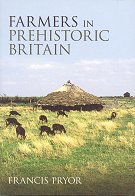
But it is the efforts of archaeologists that have done the most to elucidate the mysteries of Britain’s most celebrated prehistoric monument. Francis Pryor draws on the latest research to tell the story of the construction of Stonehenge between 3000 and 1500 BC. The building of the stones coincided with a time of slow but significant change in prehistoric Britain: populations were growing; farming was becoming more intensive; an infrastructure of roads, rivers and settlements was being developed. Stonehenge was a source of stability for our early Bronze Age ancestors in an age of cultural transformation.
Accessible and authoritative, Stonehenge offers a fascinating and revelatory account of the history and meaning of a sacred landscape.
Francis Pryor, who has spent decades digging its soils as a working archaeologist and raising sheep on its fertile meadows, weaves together strands of archaeology, history and personal experience to create an affectionate, richly informative and deftly executed portrait of a complex and threatened landscape.
Whether writing about the early human family who trod the estuarine muds of Happisburgh in Norfolk c.900,000 BC, the craftsmen who built a wooden trackway in the Somerset Levels early in the fourth millennium BC, or the Iron Age denizens of Britain’s first towns, Pryor offers remarkable insights into our early history, and a convincing, well-attested and movingly human portrait of prehistoric life as it was really lived.
Braving the winter winds and summer droughts of the Fen country, the Pryors set about creating a garden that was ambitious in scope but human in scale. They planted a wood that, in time, would be carpeted in snowdrops and bluebells; an orchard for traditional varieties of apple and pear; and a vegetable garden to ensure self-sufficiency in asparagus and Brussels sprouts. Around the central axis of a ‘long border’, they built an interconnected ensemble of beds, borders, paths and walks, punctuated by places to rest and reflect in, and by one or two hidden surprises…
A Fenland Garden is shot through with the empirical wisdom of a writer with a very special relationship with landscape and the soil. Francis’s account of the garden at Inley Drove is counterpointed by nuggets of Fenland lore, by walks in the woods with the dogs Pen and Baldwin, and by vignettes of the plantsman’s trials and tribulations. It is the story of bringing something beautiful into being, of embedding a garden in its local landscape, and of reclaiming for nature one small patch of English ground.
That is, until a chance discovery of a newspaper article reveals that Ali Kabul, a young volunteer from a dig he supervised, has been accused of murdering his own sister. Convinced that All is innocent, Alan embarks on his own private investigation which takes him into the depths of prison society and the heights of modern-day English aristocracy. But the deeper Alan digs into the mysteries of the past, the more he is forced to question everything that he previously held as true.
This gripping debut thriller by Time Team archaeologist Francis Pryor is a study of family, identity and honour. Set in the fens, the wild landscape is a character in its own right: full of secrets, waiting to be discovered.
When he is contacted by his partner in crime, DCI Lane, with the news that his old friend and fellow archaeologist Stan Beaton has been found drowned in a river, Alan’s life is turned on its head. Stan had been surveying the estate of the Cripps family, a large, insular clan, which, according to local gossip, is cursed.
The Crippses recruit Alan to continue Stan’s work, but this proves more than he bargained for. What he uncovers there soon attracts media attention: the site becomes the focus of the next series of popular archaeology TV show Test Pit Challenge, and Alan himself becomes a reluctant media sensation.
However, the world portrayed by the cameras is a far cry from the rivalries and dysfunction behind the scenes. Then, when Alan’s old flame Harriet, a bones specialist, appears at the dig, things get really complicated.
Determined to discover the truth behind Stan’s death, Alan’s obsessive investigation reveals that the mysteries of the present are rooted in the long-buried secrets of the past. As more ‘accidental’ deaths pile up, it seems that the Cripps Curse may be more than idle superstition. The only question is, who will be the next victim?
The Fens of eastern England form a very distinct environment which produced particular patterns of prehistoric human occupation. The unusual environmental conditions also meant that special excavation techniques had to be used, some of them developed as the work progressed. Francis Pryor is also concerned with ecological aspects and the problems of conservation and presentation of the sites, including modern experimental reconstructions and the opening of Flag Fen to visitors.
With over 100 maps, plans, reconstructions and photographs, this is the complete companion to Flag Fen and its region.